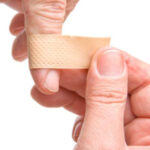Key Facts
- You can treat most minor cuts/scrapes at home.
- First, stop the bleeding, and then clean the wound.
- Watch for signs of infection: redness, pus, pain, swelling, fever.

Most cuts and scrapes are small injuries that can be treated at home, but it’s good to know when to get medical care for yourself or someone else.
Wound care:
- Stop any bleeding by applying gentle pressure with a clean cloth or bandage
- Wash your hands with soap and water before and after touching the wound
- Clean the cut/scrape by holding the wound under a faucet of running water (NOT hot water). You may use mild soap but don’t scrub initially. Dirt and pebbles will often come out of the cut by holding the wound under a faucet for about 1-3 minutes (you can also rinse the cut/scrape with a cup of water). If there’s still a black color from road burn after washing, you can gently scrub for 15 minutes. If there’s still a black color, you need to see a health professional to ensure the gravel is out of the wound.
- Let the cut/scrape air-dry or lightly dab it with a clean bandage or cloth
- Apply an antibiotic ointment
- Cover the area with a Band-Aid or non-stick gauze pad
- Use paper tape or a gauze wrap to hold the gauze pad in place
- Keep the wound clean and dry: After cleaning the wound, apply a small amount of the antibiotic ointment and change the bandage every day (more frequently if it gets wet), until it is completely healed.
- Check for signs of infection: Redness, pus (yellow and/or green drainage), pain, swelling, and/or warm to touch.
- When the wound turns a light pink color, you may stop applying the antibiotic ointment and leave it uncovered.
When should I get medical care?
Because most cuts and scrapes are minor, they can be treated at home using the tips listed above. However, some injuries are more serious.
You should call your health care provider right away or go to the closest emergency room if the wound is:
- Bleeding a lot – you can’t stop it after (5-10 minutes) of pressure with a bandage or clean cloth
- Very painful
- Ragged around the edges
- Open, wide, or jagged – You may need to see a health care provider for a special medical glue, steri-strips, or stitches
- Close to the eye or on the face – even a small cut on the face should be checked by a health care provider because of the risk of a scar.
- Caused by a nail, or other sharp, pointy, dirty, or rusty object
- Black or brown color from “road burn” after washing (which can mean that there’s still dirt and tiny rocks in the scrape that you need a health professional to scrub away)
- Swelling over a bone or joint
- Caused from an animal or human bite
- Showing signs of infection (see below)
- You should also call your health care provider if you haven’t had (or can’t remember having) a tetanus vaccination in the past 5 years.
How can I prevent a wound infection?
As long as you keep a cut/scrape clean, and change the bandage once a day, it’s unlikely that you’ll get a wound infection. Remember to keep your wound covered and don’t touch or blow on it.
How do I know if a cut or scrape is infected?
If the cut or scrape is infected, you may see one or more of these symptoms:
- Pus or cloudy fluid is draining from the wound
- Scab has gotten bigger
- Redness around the wound is worse
- More pain or swelling 48 hours after the injury
- Fever
- Wound doesn’t look like it’s healing
Call your health care provider if you have any of the symptoms above.
Is there anything I can do to prevent getting cuts and scrapes?
Yes. While we can’t always avoid getting cuts and scrapes, you can prevent them most of the time. Here’s how:
- Always wear safety gear (such as a helmet, knee and elbow pads) depending on what activity you are doing: Ex. rollerblading, biking, or other active sports
- Don’t walk barefoot
- Always protect your eyes with goggles (when using tools, etc.)
Our health guides are developed through a systematic, rigorous process to ensure accuracy, reliability, and trustworthiness. Written and reviewed by experienced healthcare clinicians from Boston Children's Hospital, a Harvard Medical School teaching hospital and consistently ranked as a top hospital by Newsweek and U.S. News & World Report, these guides combine clinical expertise, specialized knowledge, and evidence-based medicine. We also incorporate research and best practices from authoritative sources such as the CDC, NIH, PubMed, top medical journals, and UpToDate.com. Clinical specialists and subject matter experts review and edit each guide, reinforcing our commitment to high-quality, factual, scientifically accurate health information for young people.

